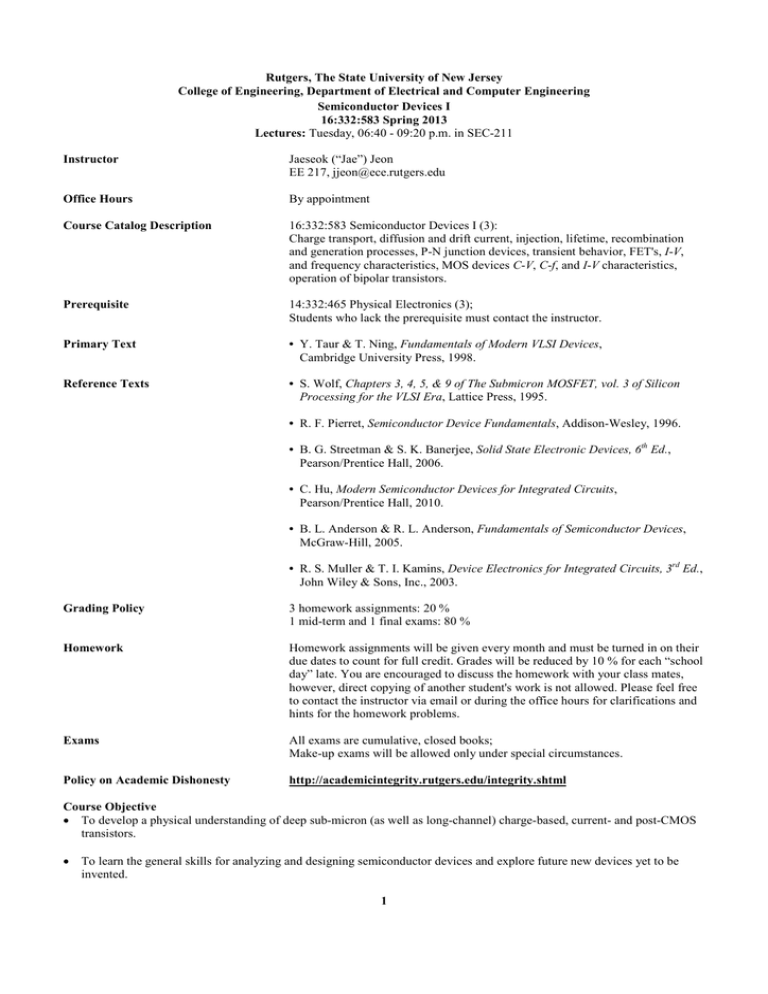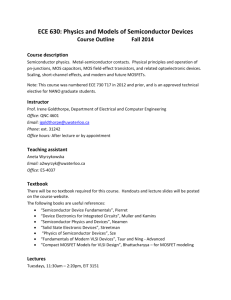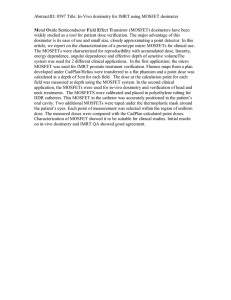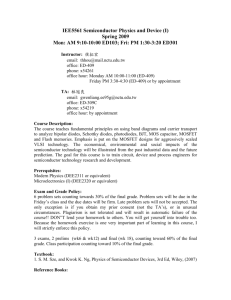
Rutgers, The State University of New Jersey
College of Engineering, Department of Electrical and Computer Engineering
Semiconductor Devices I
16:332:583 Spring 2013
Lectures: Tuesday, 06:40 - 09:20 p.m. in SEC-211
Instructor
Jaeseok (“Jae”) Jeon
EE 217, jjeon@ece.rutgers.edu
Office Hours
By appointment
Course Catalog Description
16:332:583 Semiconductor Devices I (3):
Charge transport, diffusion and drift current, injection, lifetime, recombination
and generation processes, P-N junction devices, transient behavior, FET's, I-V,
and frequency characteristics, MOS devices C-V, C-f, and I-V characteristics,
operation of bipolar transistors.
Prerequisite
14:332:465 Physical Electronics (3);
Students who lack the prerequisite must contact the instructor.
Primary Text
• Y. Taur & T. Ning, Fundamentals of Modern VLSI Devices,
• Cambridge University Press, 1998. •
Reference Texts
• S. Wolf, Chapters 3, 4, 5, & 9 of The Submicron MOSFET, vol. 3 of Silicon
• Processing for the VLSI Era, Lattice Press, 1995.
• R. F. Pierret, Semiconductor Device Fundamentals, Addison-Wesley, 1996.
• B. G. Streetman & S. K. Banerjee, Solid State Electronic Devices, 6th Ed.,
• Pearson/Prentice Hall, 2006.•
• C. Hu, Modern Semiconductor Devices for Integrated Circuits,
• Pearson/Prentice Hall, 2010.
• B. L. Anderson & R. L. Anderson, Fundamentals of Semiconductor Devices,
• McGraw-Hill, 2005.
• R. S. Muller & T. I. Kamins, Device Electronics for Integrated Circuits, 3rd Ed.,
• John Wiley & Sons, Inc., 2003.
Grading Policy
3 homework assignments: 20 %
1 mid-term and 1 final exams: 80 %
Homework
Homework assignments will be given every month and must be turned in on their
due dates to count for full credit. Grades will be reduced by 10 % for each “school
day” late. You are encouraged to discuss the homework with your class mates,
however, direct copying of another student's work is not allowed. Please feel free
to contact the instructor via email or during the office hours for clarifications and
hints for the homework problems.
Exams
All exams are cumulative, closed books;
Make-up exams will be allowed only under special circumstances.
Policy on Academic Dishonesty
http://academicintegrity.rutgers.edu/integrity.shtml
Course Objective
· To develop a physical understanding of deep sub-micron (as well as long-channel) charge-based, current- and post-CMOS
transistors.
· To learn the general skills for analyzing and designing semiconductor devices and explore future new devices yet to be
invented.
1
(Tentative) Lecture Schedule
1. Overview of Basic MOSFET (2 Weeks)
1.1. Threshold Voltage (VTH) Issues
VTH and body effect; effects of retrograde body doping ion implantation, and non-uniform doping on VTH
1.2. Basic MOSFET Theory
Channel length modulation (CLM); ideal I-V characteristic; square law, including body effect; drain saturation
voltage; saturation current (IDSAT) and transconductance (gm); bulk charge theory; charge sheet model; subthreshold
current; subthreshold swing; subthreshold slope; gain-induced drain leakage (GIDL)
2. Advanced MOSFET Physics (5 Weeks)
2.1. Off-State Characteristics of Scaled MOSFETs
MOSFET scaling theory; short-channel effect (SCE); drain-induced barrier lowering (DIBL); effect of body-bias on
short-channel effect; narrow width effect; reverse short channel effect; sub-surface punch-through
2.2. On-State Characteristics of Scaled MOSFETs
Mobility measurement; mobility dependency; scattering effects; universal mobility curve; universal surface motility;
velocity saturation; square law model vs. improved velocity saturation model; parasitic source-drain resistance; source
injection velocity limit; channel length modulation (CLM); output resistance; MOSFET device design; surface- vs.
buried-channel PMOS; latch-up
2.3. Hot-Carrier Effect
Hot electron effect; lightly-doped drain (LDD); substrate current; device lifetime; PMOS hot electron effect; oxide
interface improvement
2.4. Gate Stack Engineering (Gate Oxides and Electrodes)
Conduction in insulators; tunneling currents; dielectric reliability; oxide breakdown; hole generation / trapping model;
oxide leakage; gate stack scaling; high-K dielectrics (overview, issues, materials, and requirements); materials and
requirements for gate electrodes; work function engineering
3. Advanced Transistor Structures (5 Weeks)
3.1. Brief Overview of Modern MOSFET Fabrication Process, Including Intel’s 45 nm High-K Technology
3.2. Solutions to the Issues with Scaled Bulk MOSFETs
3.2.1. Series Resistance: Raised source/drain MOSFET; Schottky source/drain
3.2.2. Mobility: Strained silicon (technologies, device characteristics, process integration issues, junction leakage,
and strain relaxation); velocity saturation; high field transport; channel engineering
3.2.3 Leakage: Silicon-On-Insulator (SOI) (technologies, challenges, device characteristics, fully-depleted vs.
partially-depleted); ultra-thin-body (UTB) MOSFETs
3.3. Sources and Impacts of MOSFET Variation
VTH variation; random dopant fluctuation (RDF); line edge roughness (LER); random telegraph noise (RTN)
3.4. Multi-Gate MOSFETs: The “FinFETs,” which is “the only transistor design picked up by the industry.”
3.5. (Optional) Memory Technology Overview: SRAM; DRAM; Flash Memory (NAND vs. NOR)
4. Emerging Research Devices and Applications (3 Weeks)
4.1. To Enable Ultimately-Scaled Transistors
Nanowire (NW) FETs; Carbon-Nano-Tube (CNT) FETs
4.2. To Achieve Very-Low-Power Consumption
Tunneling-FETs (TFETs); Nano-Electro-Mechanical (NEM) Relays; Ferroelectric Transistors
4.3. (Optional) To Realize Denser, Faster, and Lower-Power Memory than Flash:
Resistive-RAM (RRAM); Phase Change Memory (PCM)
2




